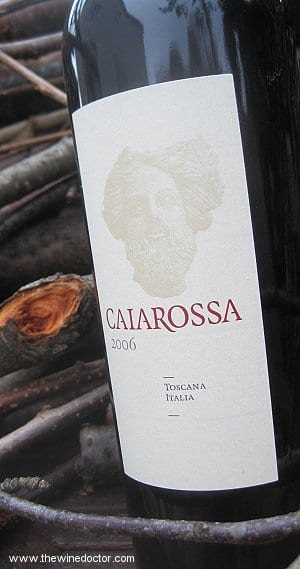Caiarossa 2006
The 2006 vintage in Tuscany seems to have been a successful one, with any number of reports from the region singing the praises of the wines. Such reports don’t always emanate from those free of bias, but they are nevertheless worth reading, even if you need a dose of salt with them. The official report from the Chianti Classico Consorzio was one of optimum ripeness combining ideal sugar levels and polyphenolic maturity or, as they rather breathlessly put it, “A great moment for our Sangiovese“. Perhaps rather more objective is Italian expert Nicolas Belfrage MW who wrote of the vintage in Wine Report 2008 (co-authored with Franco Ziliani) “In general…quality was really good…There should be plenty of interesting bottles for laying down from 2006“.
 The Caiarossa estate was only established in 1998, but seems to have been catapulted into the limelight following its acquisition by Eric Jelgersma of Château Giscours (and Château du Tertre) in 2004. It is a notable estate on many levels; the vineyard includes an eclectic mix of varieties, taking in not only Bordeaux in the shape of Merlot, Cabernet Franc, Cabernet Sauvignon and even Petit Verdot, but also the Rhône and other regions with Syrah, Grenache, Mourvèdre and Alicante. And there is Sangiovese too, of course! When I first featured the wines, in the 2004 vintage, there were only two cuvées available, although there are also now dry and sweet whites, utilising plantings of Chardonnay, Viognier and Petit Manseng. And these vineyards are all tended using biodynamic methods; a look at the Caiarossa website gives a refreshing amount of detail on what this involves, including which preparations were used (mainly herbal infusions as well as 500 and 501) and the quantity of copper employed. Overseeing the fermentations is winemaker Dominique Génot, who has been in post here since the 2006 vintage, with advice from consultant Andrea Paoletti. The ferment is kicked off by indigenous yeasts in 10-80 hectolitre wooden vats with up to 30 days of maceration; after that the 2006 vintage was left in either barriques or tonneaux (only 30% new) for 18 months on average, with a blending and a rest period in tanks for six months before going into bottle.
The Caiarossa estate was only established in 1998, but seems to have been catapulted into the limelight following its acquisition by Eric Jelgersma of Château Giscours (and Château du Tertre) in 2004. It is a notable estate on many levels; the vineyard includes an eclectic mix of varieties, taking in not only Bordeaux in the shape of Merlot, Cabernet Franc, Cabernet Sauvignon and even Petit Verdot, but also the Rhône and other regions with Syrah, Grenache, Mourvèdre and Alicante. And there is Sangiovese too, of course! When I first featured the wines, in the 2004 vintage, there were only two cuvées available, although there are also now dry and sweet whites, utilising plantings of Chardonnay, Viognier and Petit Manseng. And these vineyards are all tended using biodynamic methods; a look at the Caiarossa website gives a refreshing amount of detail on what this involves, including which preparations were used (mainly herbal infusions as well as 500 and 501) and the quantity of copper employed. Overseeing the fermentations is winemaker Dominique Génot, who has been in post here since the 2006 vintage, with advice from consultant Andrea Paoletti. The ferment is kicked off by indigenous yeasts in 10-80 hectolitre wooden vats with up to 30 days of maceration; after that the 2006 vintage was left in either barriques or tonneaux (only 30% new) for 18 months on average, with a blending and a rest period in tanks for six months before going into bottle.
The blend of Caiarossa in this vintage is very similar to that in 2004, although with one or two slight differences. Sangiovese leads with 23%, followed by 22% Cabernet Franc, 21% Merlot and 12% Cabernet Sauvignon. Lesser components include 8% Alicante, 6% each Syrah and Petit Verdot and 2% Mourvèdre. In the glass the wine has a dark and leathery-claretty hue. It takes a couple of hours to open out on the nose, so if drinking it at this tender age bear that in mind. It starts off all tight and crystalline, but with some time in the decanter it reveals aromas suggestive of a little more depth and substance, starting with a little leather, although overall its character remains intense in a crunchy-spiky style. There are cherry skins and cranberries, smoke, and nuances of dry spices to the fruit, with notes of cinnamon and cloves. More than that though it has a stony, minerally and slightly earthy-savoury character. The palate is full, tense, with the crunchy and minerally composition suggested by the nose, and a layer of bright fruit with a very dry core of robust tannins. The texture of the wine lags behind the tannic structure somewhat, and in that respect this wine resembles the 2008 Médocs to some extent. Not only the distance between the tannic backbone and the fruit, but also the spiky, crystallised-fruit character. The finish shows a dry coating of tannins with a very robust presence which really need to integrate. Not in the same league as the delightful 2004, but charming and cellar-worthy; I suspect this needs another 5-8 years at least. 16.5+/20 (22/11/10)
